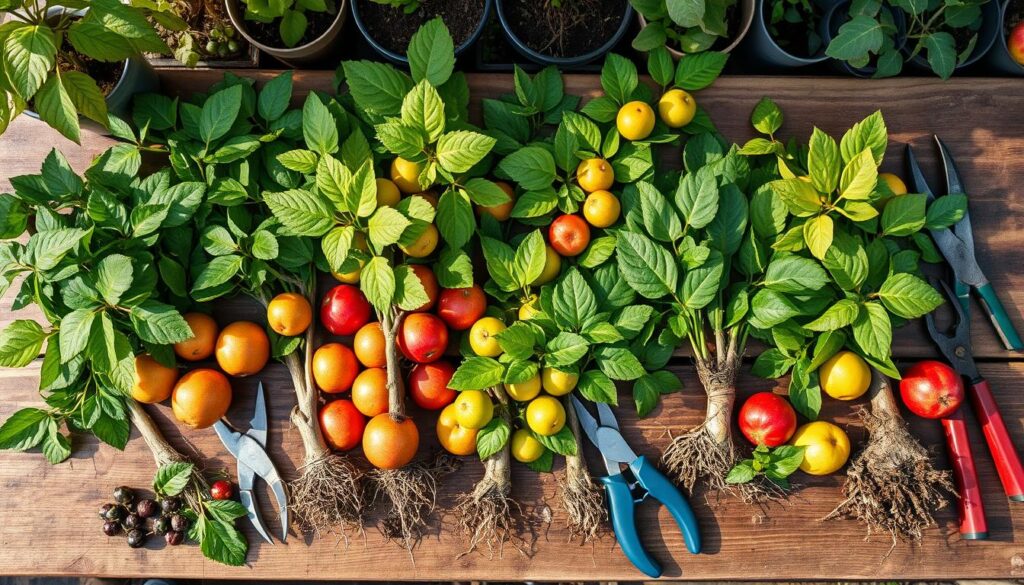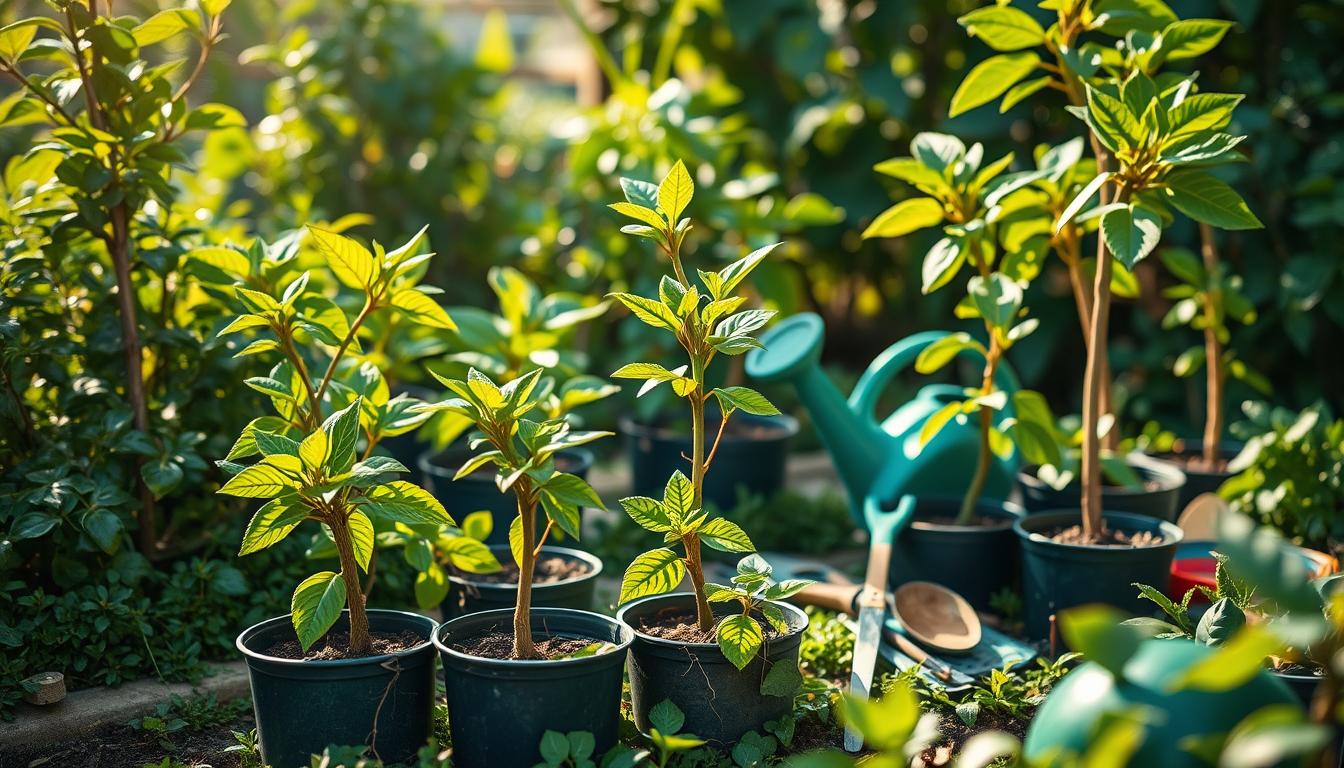Propagating fruit trees from cuttings is a fun way to grow plants without spending a lot on saplings. In this guide, I’ll show you how to do it easily. We’ll cover the basics, what you need, and how to fix common problems.
Using cuttings lets you grow trees that are just like their parents. This means your fruit will be top-notch and you’ll feel connected to nature. Let’s start this rewarding journey to grow our own fruit trees!
Key Takeaways
- Learn the fundamentals of cutting-based propagation for fruit trees.
- Understand the benefits of propagating fruit trees from cuttings.
- Explore various types of fruit tree cuttings for successful rooting.
- Identify essential tools and materials needed for effective propagation.
- Discover community support and expert advice at GardenBeginner.com.
Understanding Fruit Tree Propagation
Fruit tree propagation has many ways to grow new trees from old ones. The most common method is through cuttings. I like using cuttings because they often grow into trees just like the parent tree. This method makes growing new trees easier and more predictable.
Starting with cuttings is easier and cheaper than using seeds. Seeds might not grow into trees that produce fruit as good as the parent tree. Knowing how to choose the best method for different fruits, like apples and pears, helps a lot.
When to take cuttings is very important. Softwood cuttings are best in spring and early summer. Semi-hardwood cuttings are taken later in the year, in autumn. Hardwood cuttings are taken during dormancy, in late autumn or winter.
Using things like aloe juice can help cuttings grow roots better. Honey and cinnamon help with plant health and fight off diseases. This knowledge helps me grow a successful garden. For a detailed plan, checking out the privacy policy can be very helpful.
Benefits of Propagating Fruit Trees from Cuttings
Learning to propagate fruit trees from cuttings is exciting for gardeners. It saves money. Growing trees from cuttings is cheaper than buying saplings from a nursery. This lets me grow my garden without spending a lot.
Another big plus is getting trees with the same good traits as the parent. When I take cuttings, the new trees will have the same fruit quality and taste. This makes me feel sure about my gardening.
Also, learning to propagate improves my gardening skills. I can share my success with others and even sell extra plants. This makes my home-grown food more valuable and helps me share gardening tips.
Propagating fruit trees is rewarding. I enjoy watching my plants grow. Knowing the benefits keeps me eager to learn more about gardening.
What You Need to Get Started
Starting to grow fruit trees from cuttings can be very rewarding. Knowing what tools you need and how to pick the right cuttings is key. Getting everything ready and understanding what you need will help a lot. First, you need to gather the right tools for growing fruit trees.
Essential Tools and Materials
Here’s what you’ll need to start:
- Sharp pruning shears – Clean cuts are crucial for healthy growth.
- Pots with drainage holes – They help prevent waterlogged soil and promote healthy roots.
- Rooting medium – Options like perlite or peat moss are great for growth.
- Rooting hormone – It boosts the chances of strong root development.
Choosing the Right Fruit Tree Cuttings
Choosing the right cuttings is key for success. Look for healthy branches from the tree you want. Make sure they are disease-free. Here’s what to look for:
- Branches that are 4-6 inches long work best for rooting.
- Look for signs of vibrant growth to ensure the cutting is healthy.
Some trees, like apples, may not grow well from seed. Cuttings are a better choice, but success rates vary. For example, apple tree cuttings might only have a 2 percent success rate. Using the right techniques is crucial. Doing your own research before starting can help a lot.
| Fruit Tree | Success Rate | Rooting Timeframe |
|---|---|---|
| Gooseberry | 98% | Short-term |
| Holly | 95% | Short-term |
| Apple | 2% | Medium-term |
| Maple | 5% | Variable |
| Antonovka Rootstock | 40% | Medium-term |
Types of Fruit Tree Cuttings
Knowing the different types of fruit tree cuttings is key to successful gardening. Each type has its own benefits and challenges. This helps me pick the best option for my garden. Here, I’ll explain the three main types: softwood, semi-hardwood, and hardwood cuttings.
Softwood Cuttings
Softwood cuttings come from young, soft growth in spring. They root fast, sometimes up to 98% for plants like gooseberries. This method starts the growing season early, leading to strong plants. But, they need careful watering and protection from harsh weather.
Semi-Hardwood Cuttings
Semi-hardwood cuttings are taken in late summer. They are firmer than softwood but still easy to manage. While success rates vary, they are generally easier to handle and can root well, leading to healthy plants.
Hardwood Cuttings
Hardwood cuttings are taken in late fall or winter when the tree is dormant. They root slower but need less care. For example, rooting apple trees this way might only succeed 2% of the time. Yet, some varieties like Antonovka and b118 rootstocks can have a 40% success rate. This method is good for harder-to-propagate trees.

| Type of Cutting | Harvest Season | Success Rate | Maintenance Level |
|---|---|---|---|
| Softwood Cuttings | Spring | 98% (Gooseberries) | High |
| Semi-Hardwood Cuttings | Late Summer | Varies | Moderate |
| Hardwood Cuttings | Late Fall/Winter | 2% (Apple Trees) 40% (Antonovka, b118) |
Low |
How to Propagate Fruit Trees from Cuttings
Learning to propagate fruit trees from cuttings is rewarding. It’s a simple process that can lead to healthy new plants. First, I pick and take cuttings from the fruit tree I want. Softwood cuttings work best in late spring to early summer. Semi-hardwood cuttings are better in mid to late summer.
Each cutting should be about six inches long. This length is crucial for successful rooting.
Then, I prepare my cuttings. I remove lower leaves to prevent rot and make an angled cut at the bottom. Next, I dip the cut ends into rooting hormone to help with root growth.
For the rooting medium, I mix coarse sand, sterile peat moss, and perlite. This mix creates a perfect environment for the cuttings.
After placing the cuttings in the medium, keeping them humid is crucial. I cover them with a plastic bag or use a humidity dome. It’s important to mist them regularly and keep the medium moist.
I place them in bright, indirect sunlight at around 70 degrees Fahrenheit. This helps them grow well.
I watch the cuttings closely for root formation. Softwood cuttings show roots in about three weeks. Semi-hardwood cuttings take six weeks. When I see roots about one inch long, it’s time to transplant them into individual pots.
For the best chance of success, I take multiple cuttings. The success rate can be low.
After transplanting, I keep the cuttings indoors for at least a year. This lets them develop a strong root system before facing outdoor conditions. My care during this time ensures they thrive in the future.
Preparing Your Cuttings for Propagation
Starting to grow fruit trees from cuttings needs careful timing and treatment. I collect cuttings in the early morning to keep them fresh. This simple step helps them grow well.
Collecting Cuttings at the Right Time
Timing is key when picking cuttings. I choose healthy, strong trees. Cutting during the tree’s dormant season works best.
I also consider the specific needs of different plants. This helps in getting better results.
How to Treat Cuttings for Rooting
After getting the cuttings, treating them right is important. I start by trimming them to remove extra leaves. Using a rooting hormone helps a lot.
For a natural option, I use honey or willow water. Soaking them in aloe gel also helps. This makes my cuttings stronger and more likely to grow.
Rooting Hormones: Boosting Your Success
In my journey of growing fruit trees, I’ve learned how important rooting hormones are. They can make cuttings more likely to grow into healthy plants. Choosing the right rooting hormone depends on what you prefer and the needs of your cuttings.
Naturally Sourced Rooting Hormones
Natural rooting hormones are great for growing roots. Some good choices include:
- Willow water
- Honey
- Items like banana peels, coffee grounds, and eggshells
These natural options are easy to find and use. For example, banana peels have potassium, and coffee grounds have nitrogen and potassium. Making your own rooting hormone can help roots grow. It’s best to use it twice a week for the best results.
Commercial Rooting Hormones: Are They Necessary?
If you want fast and reliable results, commercial rooting hormones are available. They come in powdered, liquid, and gel forms. Each type is best for different types of cuttings:
| Form | Best For | Application Type |
|---|---|---|
| Powdered | Thick stem cuttings | Beginner-friendly |
| Liquid | Small or delicate plants | Precise application |
| Gel | Thin stem cuttings | Adheres to moist surfaces |
It’s key to use these hormones lightly to avoid harming the cuttings. Mixing natural and commercial rooting hormones can help you grow strong fruit trees.
Choosing the Right Medium for Rooting Cuttings
Choosing the right rooting medium for fruit trees is key to successful propagation. The choice between soil and soil-less mediums greatly affects root growth and cutting health. Knowing the differences helps in making the best choice for propagation.
Soil vs. Soil-less Mediums
Soil has long been used for rooting, offering natural nutrients and a familiar setting. However, it can hold too much water, leading to root rot. Soil-less mediums like perlite, vermiculite, and coconut coir provide better drainage and aeration. These traits help in root growth, making them a favorite among gardeners.
Preparing a Suitable Rooting Medium
To make a good rooting medium for fruit trees, mix equal parts of vermiculite and perlite. This 50/50 mix balances moisture and air, essential for root health. It creates the perfect space for cuttings to take in water without getting too wet.

Best Way to Propagate Fruit Trees
To successfully propagate fruit trees, you need the right environment. This includes consistent humidity, temperature, and indirect light. Regularly checking your cuttings helps adjust these conditions for better growth. Make sure to water them well but avoid over-saturation.
Creating the Ideal Environment for Rooting
Rooting fruit trees best in warm, humid conditions. A greenhouse or a clear plastic bag can keep the cuttings warm and humid. Choose a spot with partial shade to prevent damage from direct sunlight. Planting three to five cuttings for each fruit crop increases your chances of success. Some popular fruits for propagation include:
- Blueberries (5-6 inches long)
- Blackberries (tip cuttings from primocanes, taken in late summer)
- Currants (12-inch cuttings from one-year-old wood in late winter)
- Elderberries (softwood cuttings taken in early summer)
- Figs (8-inch branches in early spring)
- Mulberries (12-inch cuttings from soft branches in late winter)
Caring for Your Cuttings During the Rooting Process
Proper care is key for fruit tree cuttings to thrive. They need daily watering to stay hydrated. It’s important to manage moisture levels to prevent drowning. While rooting hormones can help, they’re not necessary for these fruits. Watch how your cuttings respond to adjust your care routine.
| Fruit Crop | Cutting Length | Best Time to Take Cuttings | Time to Bear Fruit |
|---|---|---|---|
| Blueberries | 5-6 inches | Softwood or hardwood | 2-3 years |
| Blackberries | Tip cuttings | Late summer | – |
| Currants | 12 inches | Late winter | – |
| Elderberries | Softwood cuttings | Early summer | 3 months |
| Figs | 8 inches | Early spring | – |
| Mulberries | 12 inches | Late winter | – |
Alternative Methods: Air Layering and Grafting
Exploring air layering fruit trees and grafting fruit trees can boost my skills. Air layering lets me create new plants while the branch stays on the tree. It has a success rate of 99%, with over 2,000 trees showing less than 1% failure.
Air layering is great for tropical fruit trees hard to root otherwise. It works well for mamey sapote, lychee, and persian limes. The best branches are pencil-sized to ¾ inch thick.
The best time for air layering is spring and summer. Roots start to grow in one month to six months, depending on the tree.
Keeping the moss ball moist is key. Check it weekly, especially in hot weather. Once roots grow, the new plants can be potted and moved to their new home.
Grafting combines a rootstock with a scion for specific fruit traits. It lets me choose taste and disease resistance. Learning both air layering and grafting opens up more possibilities for growing fruit trees. For more info, check out this resource on plant propagation methods.
Common Challenges in Fruit Tree Propagation
Exploring the challenges in fruit tree propagation, I find root rot to be a big problem. It’s crucial to address these issues to improve my success rate.
Identifying and Preventing Root Rot
Root rot comes from too much water or bad drainage. It harms young trees. To prevent it, I check for signs like yellow leaves or a bad smell. I also make sure the roots get enough air.
Using soil that drains well or a mix without soil helps keep cuttings healthy.
Understanding Success Rates
Success rates vary with different methods. Knowing these rates helps me set goals and adjust my methods. Grafting is common, letting me pick rootstocks for tree size and vigor.
For example, M9 rootstocks grow trees to 8-10 feet. M111 and M2 can reach 25 feet. Understanding this helps me plan for the best results.
Conclusion
Propagating fruit trees from cuttings has greatly expanded my gardening. It lets me grow healthy trees that give me delicious fruits every year. This summary of propagating fruit trees shows the importance of patience and technique.
My attempts with apple tree cuttings taught me a lot. Even though success can be low at first, sticking with it pays off. This is especially true in the first year.
With over 25 years of experience, I’ve seen the potential in these methods. The type of cutting and the environment are key to success. Using the right techniques is essential for the best results.
Looking back, I see that growing fruit trees is not just good for the environment. It also makes my garden more fruitful. For more tips and to connect with other gardeners, I can visit the Contact page.



Leave a Reply